Uncategorized
How Much Forage Does a Cow Eat? The Number That’ll Blow Your Mind!
Surprising facts about cow forage intake will leave you amazed—discover the numbers that can transform your herd’s health and productivity!
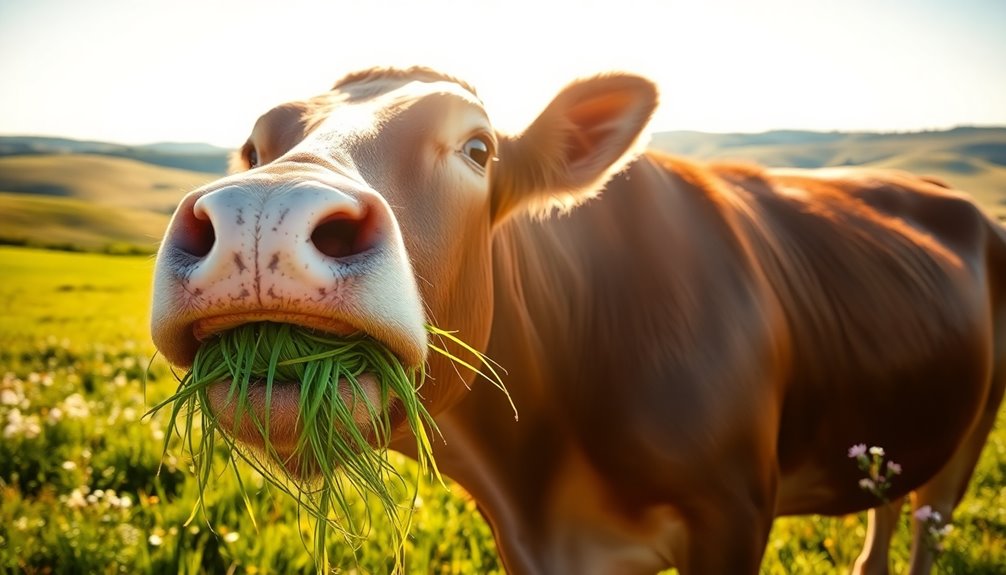
Cows can eat an eye-popping 2.5% to 2.7% of their body weight in forage daily, especially if they're lactating and on high-quality pastures. For a 1,200-pound cow, that means consuming around 30 pounds or more of forage each day! Factors like the cow's size, the forage quality, and whether they're pregnant or lactating all impact their intake. Higher-quality forage lets cows consume more, boosting their health and productivity. Want to uncover more fascinating facts about cow nutrition and feeding practices? There's plenty more to explore about how to optimize your herd's forage intake!
Key Takeaways
- A lactating cow weighing 1,200 lbs can consume up to 36 lbs of quality forage daily.
- Dry matter intake (DMI) typically ranges from 1.8% to 2.7% of a cow's body weight.
- High-quality forage (≥8% crude protein) allows for greater intake compared to low-quality forage (<6% crude protein).
- Seasonal changes can significantly impact daily forage consumption and availability.
- Larger cows require more forage, directly correlating their size with consumption levels.
Understanding Dry Matter Intake
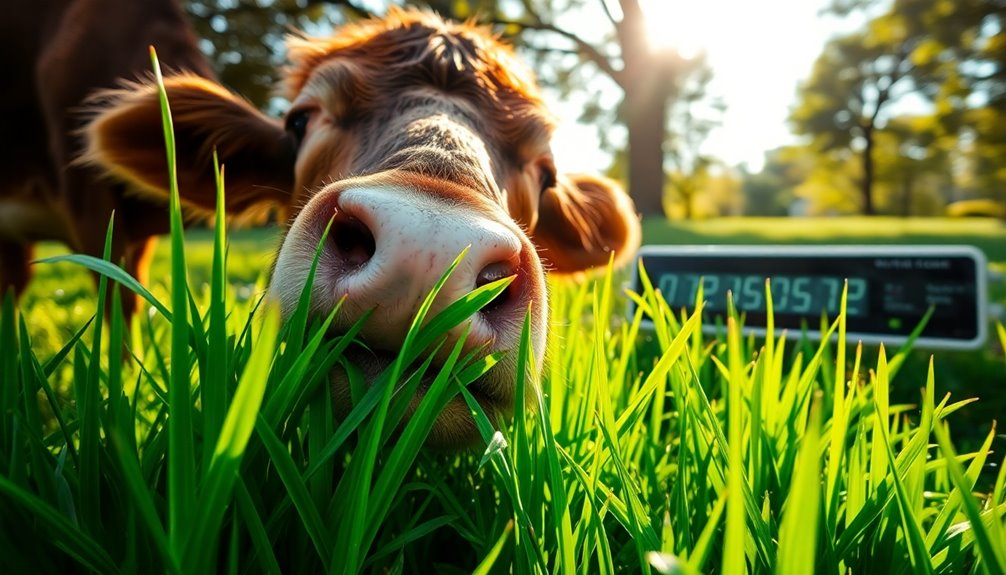
When it comes to managing your cattle's nutrition, understanding dry matter intake (DMI) is key. DMI refers to the amount of feed consumed after excluding moisture content, which is essential for accurate nutritional assessments.
For instance, a 1,200 lb cow that eats 24 lb of hay at 88% dry matter actually consumes about 27 lb on an as-fed basis due to moisture.
Factors like forage quality, cow weight, and lactation status greatly impact daily DMI. Lactating cows generally consume more than non-lactating cows to meet their nutrient needs, often reaching 2.5%-2.7% of their body weight when eating high-quality forages like corn silage.
Monitoring DMI helps you manage forage inventory effectively, particularly during periods of scarcity like calving, ensuring you minimize hay wastage and optimize feeding strategies.
Factors Influencing Forage Consumption
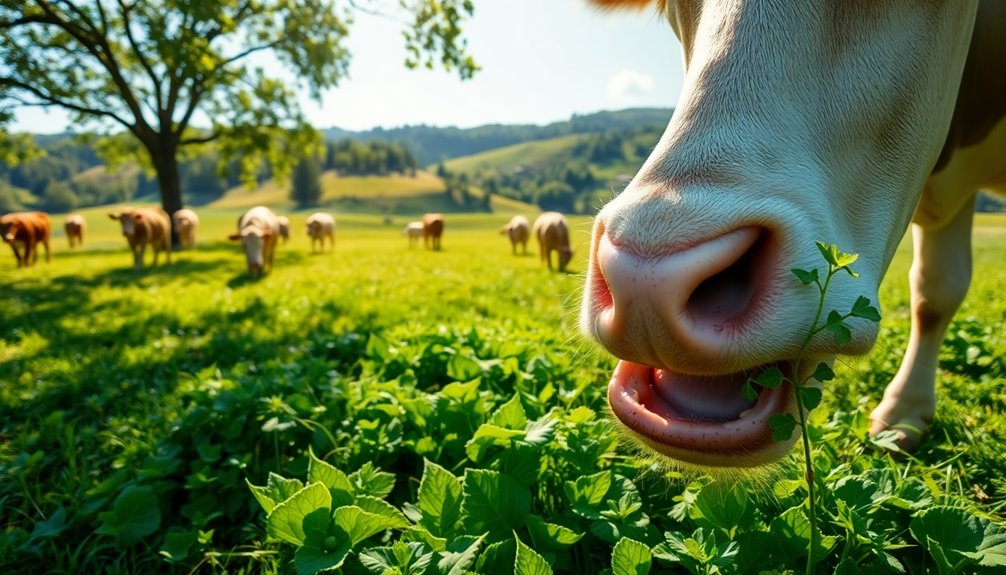
Forage consumption in cows is influenced by several critical factors, including forage quality, cow condition, and environmental conditions. Understanding these influences can help you enhance your cows' forage intake and overall health.
- Forage Quality: High-quality forage can increase daily intake considerably.
- Body Weight: A cow's size impacts its overall consumption; larger cows eat more.
- Nutrient Content: The Total Digestible Nutrients (TDN) in forage determines how much energy and nutrients a cow receives.
- Seasonal Variations: Changes in pasture availability can affect feeding needs.
For instance, a 1,200 lb lactating cow can consume about 28 lb of high-quality forage daily, especially when it contains around 55% TDN. In contrast, if you're feeding low-quality forages (≤52% TDN), expect a consumption rate of about 1.8% of body weight for non-lactating cows.
Additionally, lactating cows require about 50% more TDN than dry cows, demanding increased forage intake during their lactation period. By factoring in these elements, you can guarantee your cows receive ideal nutrition to maximize their productivity and health.
Quality of Forage Matters
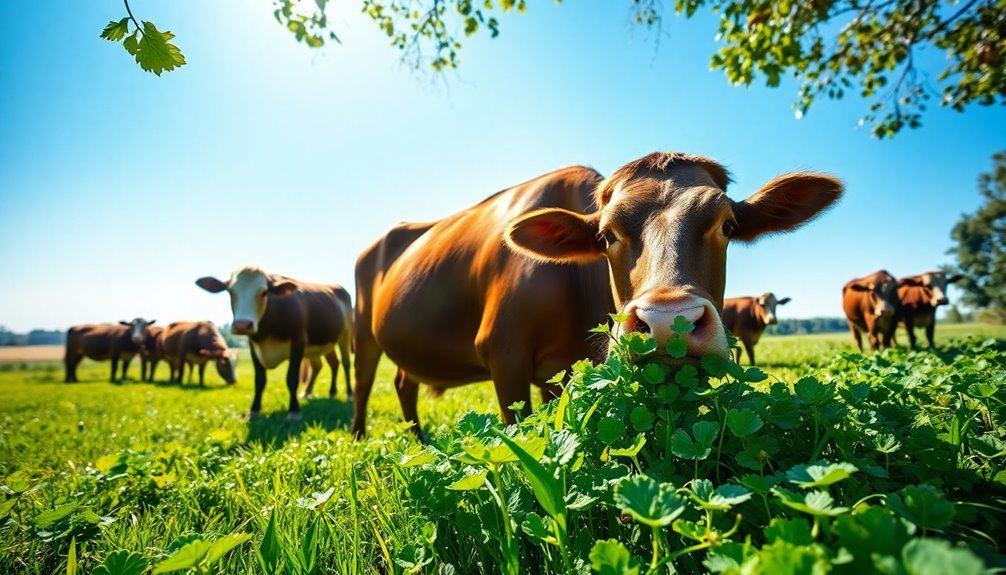
Quality of forage plays an essential role in determining how much cattle consume and their overall health. It's fascinating how the nutrient content can impact a cow's intake. For instance, when you provide low-quality forage with less than 6% crude protein, your cow may only consume around 1.5% of its body weight daily. In contrast, higher-quality forage containing at least 8% crude protein allows for approximately 2% body weight intake.
Here's a quick look at how different forage qualities can affect intake:
| Forage Quality | Crude Protein (%) | Daily Intake (Pounds) |
|---|---|---|
| Low Quality | < 6% | ~18 lbs (1.5% BW) |
| Good Quality | 8% | ~24 lbs (2% BW) |
| Excellent Quality | ≥ 8% | ~30 lbs (2.5% BW) |
| High Digestibility | 55% TDN | ~28 lbs (Lactating) |
| Mature Forage | Varies | Reduced Intake |
The digestibility of these forages is significant. Better digestibility means your cow can absorb more nutrients, leading to improved health and productivity. Prioritizing quality forage is essential for maximizing your cow's potential.
Estimating Daily Feed Requirements
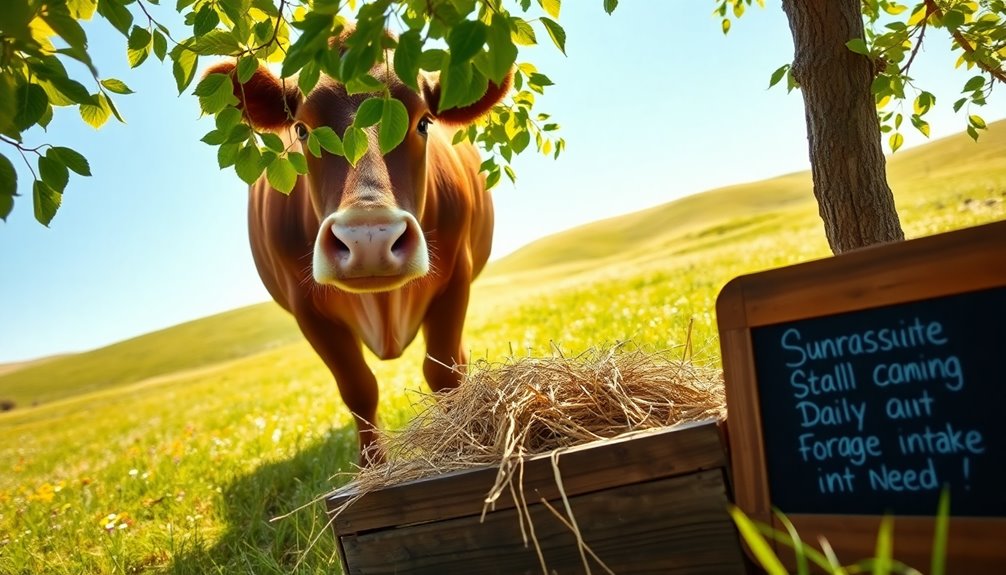
Understanding how much feed your cows need is essential for maintaining their health and productivity, especially after exploring how forage quality impacts their intake. When estimating daily feed requirements, you must consider factors like body weight, moisture content, and nutrient needs.
- A 1,200 lb pregnant cow typically consumes about 24 lbs of good-quality grass hay daily, factoring in a 15% hay wastage rate, which brings it to around 30 lbs.
- Lactating cows need more, consuming up to 36 lbs of as-fed hay daily to meet their heightened energy and nutrient needs.
- Dry matter intake for non-lactating cows is about 1.8% to 2.1% of their body weight, while lactating cows can reach 2.5% to 2.7%.
- Accurate estimates of daily feed intake help manage your forage inventory, especially during scarce periods.
Seasonal Feeding Strategies
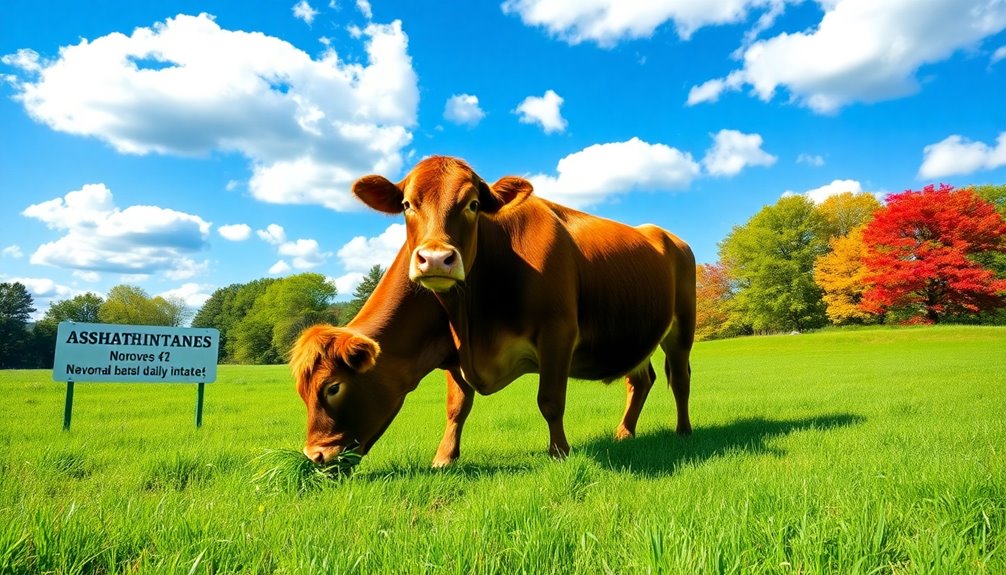
Adapting your feeding strategies throughout the seasons is vital for maintaining ideal cow health and productivity. Seasonal variations in forage availability can drastically affect your hay feeding needs, especially during fall and winter months when standing forage may be limited.
In the fall, utilizing native and Bermudagrass pastures can help reduce reliance on hay, allowing you to make the most of your available forage resources.
As winter sets in, you'll likely find pastures covered in snow or ice, making hay feeding more necessary. This is when it's important to accurately estimate your cows' daily intake needs to guarantee they receive the nutrition they require.
Keeping historical records of forage availability can assist you in predicting how long you'll need to feed hay and plan for any potential shortages.
Moreover, implementing supplementation programs during times of lower-quality forage can greatly enhance digestion and nutrient absorption, further supporting cow health and productivity.
Frequently Asked Questions
How Much Forage Does a Cow Eat per Day?
When you consider how much forage a cow eats daily, it really varies based on several factors.
A typical 1,200 lb pregnant cow usually consumes around 24 lbs of good-quality hay, but that can increase if the cow is lactating or if the forage quality is exceptional.
Generally, you can expect a non-lactating cow to eat about 2.0% of its body weight in good-quality forage, adjusting for moisture and wastage.
What Is the Mental Capacity of a Cow?
Cows have a remarkable mental capacity, comparable to that of a human toddler.
You'll find that they can solve problems and remember experiences for years. They recognize faces, both of other cows and humans, showcasing their strong memory.
Plus, they can learn by observing others, which helps them adapt.
Cows also experience emotions like joy and stress, affecting their well-being, and they communicate through vocalizations and body language to convey their feelings.
How Much Hay Will a 1200 Pound Cow Eat?
Imagine your 1,200-pound cow as a voracious bookworm, devouring pages of hay daily.
She'll munch through about 24 pounds of good-quality hay, about 2% of her body weight.
But wait! If the hay's moisture content is considered, that number jumps to around 26 pounds.
Factor in some wastage, and you'll need to provide about 30 pounds daily to keep her satisfied and healthy.
Adjust her intake as her needs change, especially after calving!
How Much Does a 1000 Lb Cow Eat a Day?
A 1,000 lb cow typically eats about 20 to 24 lbs of dry matter each day, which is roughly 2.0% to 2.4% of its body weight.
If you're feeding hay, that translates to around 25 to 28 lbs on an as-fed basis, depending on moisture content.
Keep in mind that quality matters; high-quality forages can increase intake to about 25 lbs or more.
Be sure to account for hay wastage, too!
Conclusion
To sum up, understanding how much forage a cow eats can really change your perspective on cattle management. Did you know that a single cow can consume up to 2.5% of its body weight in dry matter daily? That's around 30-40 pounds for an average cow! By considering factors like forage quality and seasonal variations, you can optimize your feeding strategies. Keeping these insights in mind can lead to healthier cattle and better yields for your farm.
Uncategorized
How Tall Do Forage Oats Get? Farmers Can’t Believe the Growth!
Incredible heights of forage oats can astonish farmers; discover the secrets behind their growth and how to achieve optimal yields.
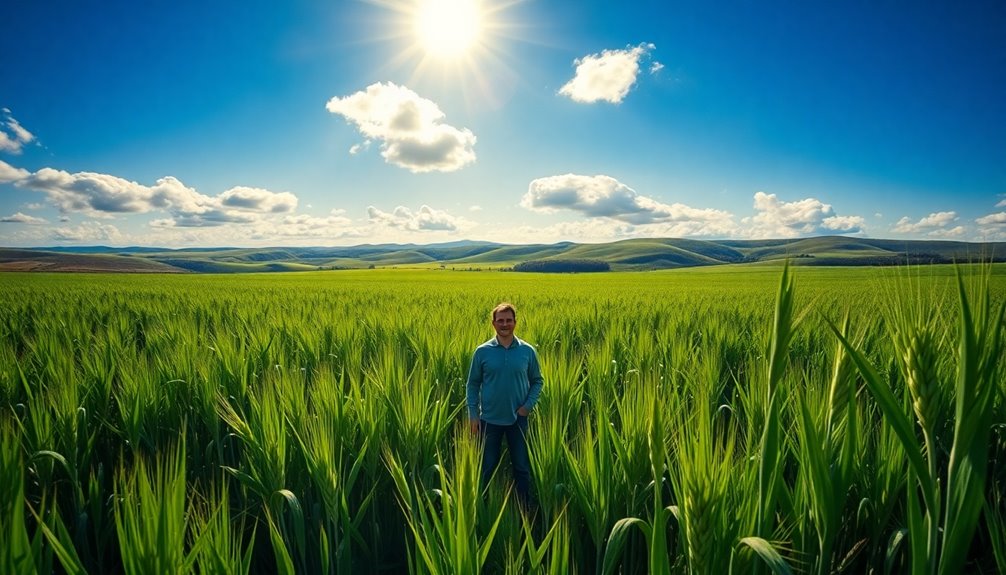
Forage oats can reach impressive heights between 2 to 4 feet, which often surprises farmers. Their growth largely depends on factors like soil quality, moisture, and variety. For instance, winter oats tend to grow taller than spring oats due to better tillering. To optimize height, make certain you've got nutrient-rich, well-drained soil and consider factors like planting density and nitrogen levels. Maintaining the ideal growth height is essential for quality forage. If you want to uncover more about maximizing your oat yield and other effective strategies, there's plenty more to explore.
Key Takeaways
- Forage oats typically grow between 2 to 4 feet tall, depending on the variety and growing conditions.
- Winter oats generally reach greater heights than spring oats, which may only grow 1.5 to 3 feet.
- Growth height is influenced by factors like soil quality, moisture, temperature, and planting density.
- Early maturity allows for multiple cropping cycles, maximizing overall height and yield potential.
- Proper management practices, like nitrogen fertilization and mowing, can enhance oat height and forage quality.
Overview of Forage Oats
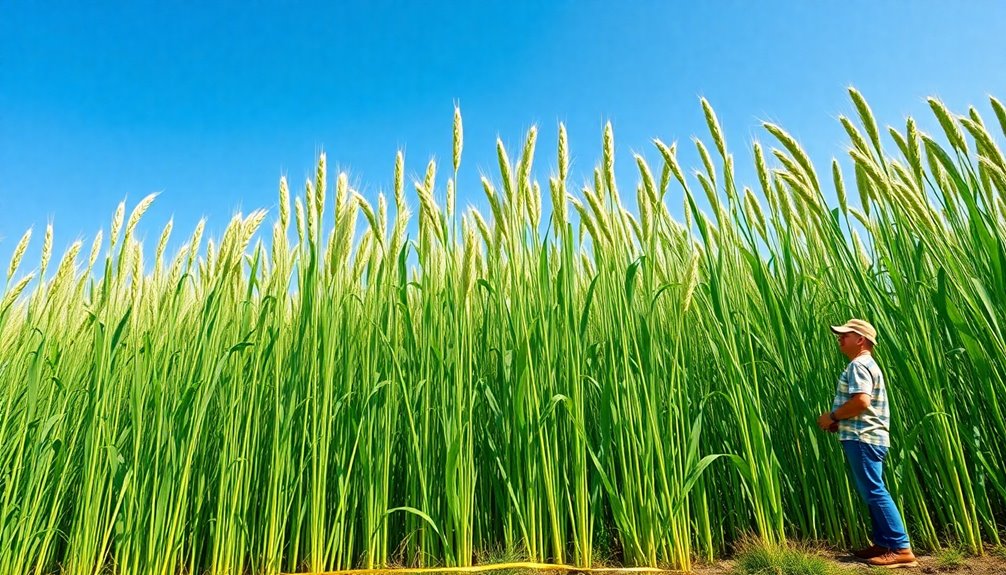
Forage oats are an excellent choice for livestock feed, thanks to their impressive growth and nutritional benefits. These oats are specifically bred to reach heights of 2 to 4 feet, depending on the variety and growing conditions. Their growth patterns allow for early maturity, giving you the chance to achieve multiple cropping cycles in a single growing season. This is especially advantageous for maximizing your feed resources.
With a rich nutritional profile, forage oats offer high digestibility and palatability, making them particularly appealing to livestock like cattle and sheep. This guarantees your animals receive the nutrients they need for peak health and productivity.
Moreover, forage oats can be intercropped with legumes, which enhances nitrogen fixation and greatly improves soil health. Their extensive root systems also contribute to better soil structure and moisture retention, promoting overall agricultural sustainability. Additionally, incorporating forage oats into your crop rotation can further optimize feed efficiency, ensuring a sustainable and productive farming strategy.
Factors Influencing Oat Height
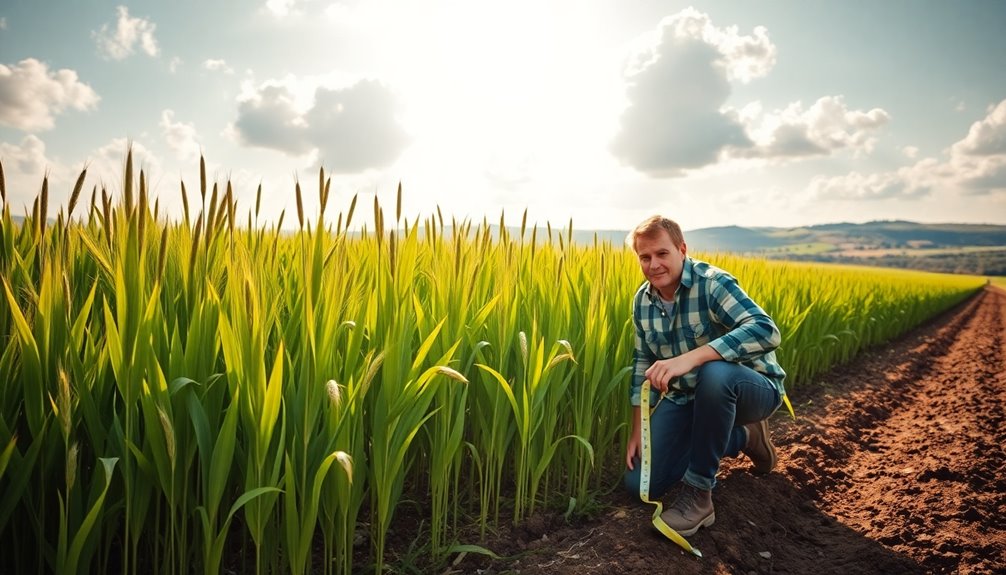
Height in forage oats is influenced by several vital factors that can noticeably affect their growth potential. One of the most important is soil quality. Nutrient-rich, well-drained soil greatly enhances growth, allowing your oats to reach impressive heights. Conversely, poor soil can stunt their development.
Weather factors also play an important role. Adequate moisture from rainfall and ideal temperatures contribute to increased height and overall plant vigor. Without the right climate conditions, your oats may struggle to thrive.
Planting density is another significant factor. When you plant oats too closely, they compete for resources, which can lead to reduced growth. It's important to find the right spacing to guarantee your plants have enough room to flourish.
Finally, fertilization practices, particularly nitrogen application, can promote taller growth. However, be cautious; excessive nitrogen might cause lodging, which can compromise plant quality and stability.
Common Varieties and Their Heights
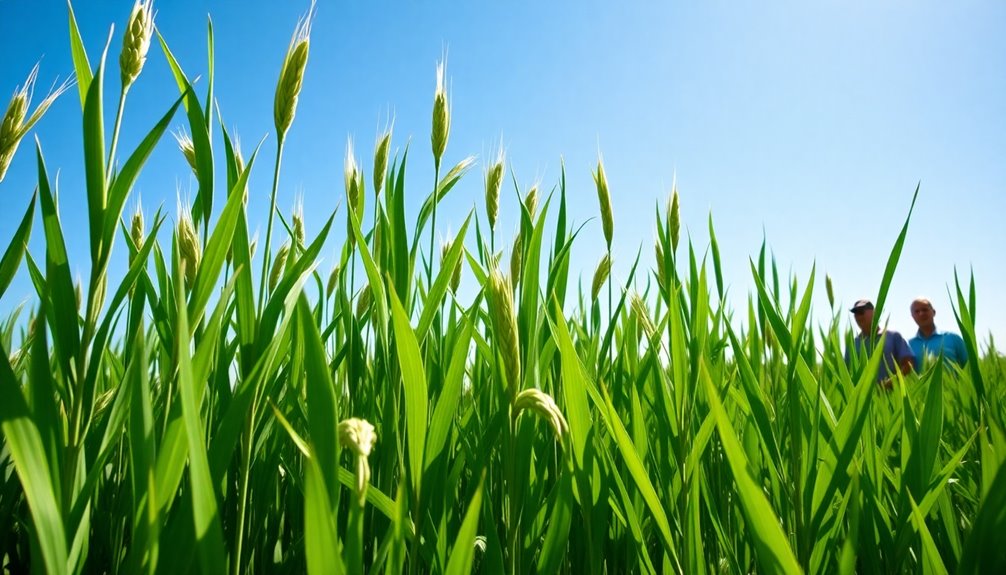
When selecting the right varieties of oats for forage, it's important to contemplate how different types can affect growth and yield. Common forage oat varieties, like Avena sativa, are specifically bred for livestock feed. These varieties often exhibit vigorous growth, reaching heights of 2 to 4 feet under ideal growth conditions.
Winter oats, in particular, stand out due to their better winter hardiness and can grow taller than spring oats. While winter oats thrive, spring oats may struggle to tiller effectively, typically reaching only 1.5 to 3 feet in height.
If you're aiming for dense stands that attract deer, choosing the right oat varieties is essential. To maximize growth and yield, confirm you're planting in well-drained, nutrient-rich soils and adhering to proper soil conditions.
Additionally, monitor height measurements throughout key growth stages. Ideally, maintain your forage oats around 3-4 inches for ideal deer attraction before they reach maturity. This approach not only enhances the height of your crop but also boosts its overall productivity, making it a win-win situation for your forage needs.
Ideal Growing Conditions
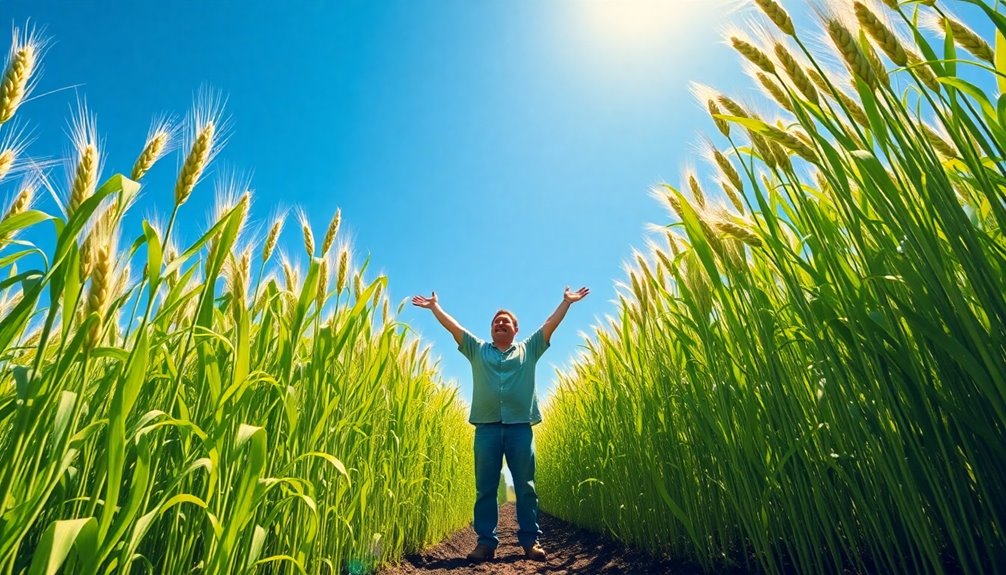
To achieve ideal growth for your oats, it's essential to focus on the right environmental conditions. The height and yield of your forage oats will greatly depend on several factors that promote their development.
- Choose the right oat variety for your region.
- Verify you have nutrient-rich soil with a pH around 7.0.
- Monitor for regular rainfall to keep the soil moist.
- Aim for moderate temperatures to support growth.
- Fertilize adequately, especially with nitrogen, to boost plant height.
Forage oats thrive in prime growing conditions, which include well-drained, nutrient-rich soil. They flourish in cool, moist climates, making regular rainfall vital.
Early planting, ideally in late August to early September, helps your oats establish strong roots before frost. This timing enhances their growth, making them more attractive to deer and other wildlife. Additionally, insulation upgrades can improve overall crop resilience by maintaining soil temperature.
Impact of Soil Quality
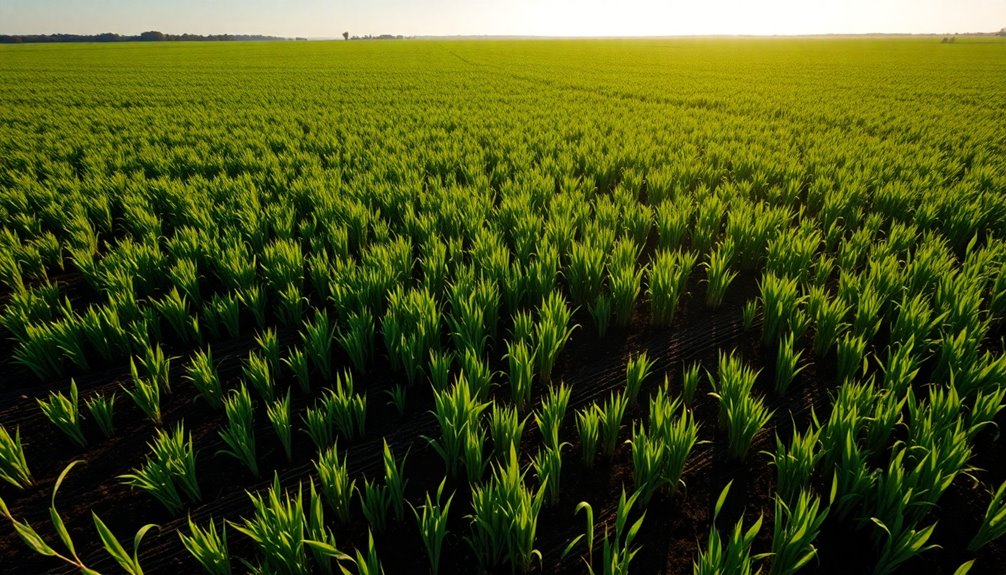
The quality of your soil plays a vital role in the success of your forage oats. When you start with nutrient-rich, well-drained soil, you set the stage for ideal plant height and yield potential. High organic matter content in your soil contributes to better root development, which enhances moisture retention and promotes overall growth.
To achieve the best results, aim for a soil pH around 6.0 to 7.0. This range promotes nutrient availability, which is essential for maximizing both the height and palatability of your forage oats. If your soil suffers from compaction or low fertility, you'll likely see stunted growth and shorter, less productive plants.
Regular soil testing is key to understanding your soil quality. By testing, you can identify deficiencies and make necessary amendments. Adding lime can help adjust pH, while balanced fertilizers supply the essential nutrients your forage oats need to thrive.
With the right soil quality, you're not just growing oats; you're cultivating success in your farming endeavors. So, invest in your soil, and watch your forage oats reach impressive heights!
Deer Preferences and Feeding Behavior
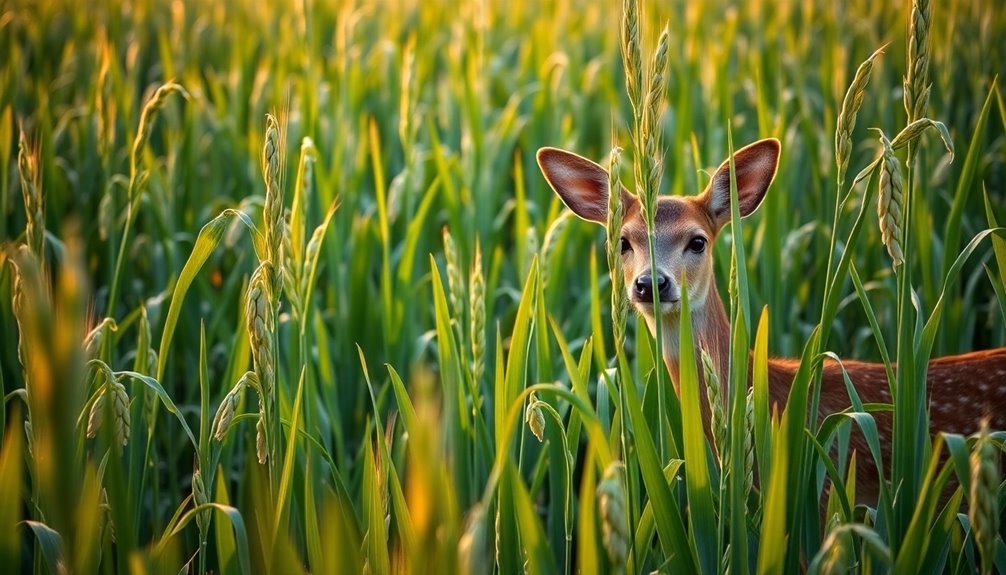
When planting forage oats, you should consider deer preferences for ideal growth.
They tend to favor oats at about 3-4 inches tall, as taller plants lose their appeal.
Plus, understanding seasonal foraging patterns can help you create food plots that attract deer when their nutritional needs peak.
Optimal Plant Height
At around 3-4 inches, forage oats present the most enticing option for deer, as they prefer these young, tender shoots over taller, more mature plants. If you want to attract deer effectively, keeping your forage oats at this ideal height is vital. Here's why:
- Increased palatability: Young shoots are more flavorful for deer.
- Enhanced feeding behavior: Deer are more likely to visit when oats are at their ideal height.
- Reduced competition: Taller plants lose appeal, leading to decreased deer attraction.
- Promotes new growth: Mowing before oats reach excessive heights boosts fresh shoots.
- Higher visitation rates: Monitoring and maintaining the right height keeps deer coming back.
Once oats grow beyond 8-10 inches, they start to lose their attractiveness. Mature plants often develop grain heads, further decreasing their palatability.
Consequently, it's important to monitor the height of your forage oats consistently. By doing so, you can guarantee that you're providing the best feeding conditions for deer, ultimately enhancing their presence on your land.
Keep those oats at the right height, and watch your deer population thrive!
Seasonal Foraging Patterns
Monitoring the height of your forage oats isn't just about keeping them attractive; it also influences deer foraging patterns throughout the seasons. Deer will eat the young, tender growth stages of forage oats, with ideal heights around 3-4 inches.
As the seasons shift, food availability changes, leading to increased deer visits to your food plots during late summer and fall. Here, forage oats are at their most nutritious, drawing deer in for a hearty meal. Pet therapy can also be beneficial to caregivers managing deer populations, as it helps reduce stress and improve focus during demanding tasks.
After the first frost, the sweetness of your oats enhances their appeal, prompting deer to forage more aggressively. This behavior continues into winter, as deer seek out established oat fields, even digging through snow if necessary.
The high nutritional value of fall-planted forage oats makes them a top choice for deer, who show a marked preference for these over spring-planted varieties. Additionally, understanding sustainable harvesting practices can help ensure that forage oats remain a reliable food source for deer season after season.
Nutritional Preferences of Deer
Deer have distinct nutritional preferences that greatly influence their feeding behavior. One of their favorites is young, tender forage oats. These juvenile growth stages are highly palatable and digestible, making them irresistible to deer.
When you're managing your food plots, keep this in mind:
- Deer really love young, tender forage oats.
- Palatability decreases when oats grow taller than 3-4 inches.
- Seasonal food availability, like acorns and clover, affects their foraging habits.
- Post-frost, oats become sweeter and more attractive to deer.
- Monitor deer activity closely, especially in winter months.
As the forage oats mature, deer tend to avoid them, shifting their focus to other food sources.
During late summer and fall, you'll notice deer foraging more aggressively in well-established food plots, particularly when oats are young and tender.
If you want to attract deer to your property, prioritize cultivating these young oats, especially after frost. They'll be drawn to the sweet, nutritious food, helping you create a thriving environment for deer.
Effective Planting Strategies
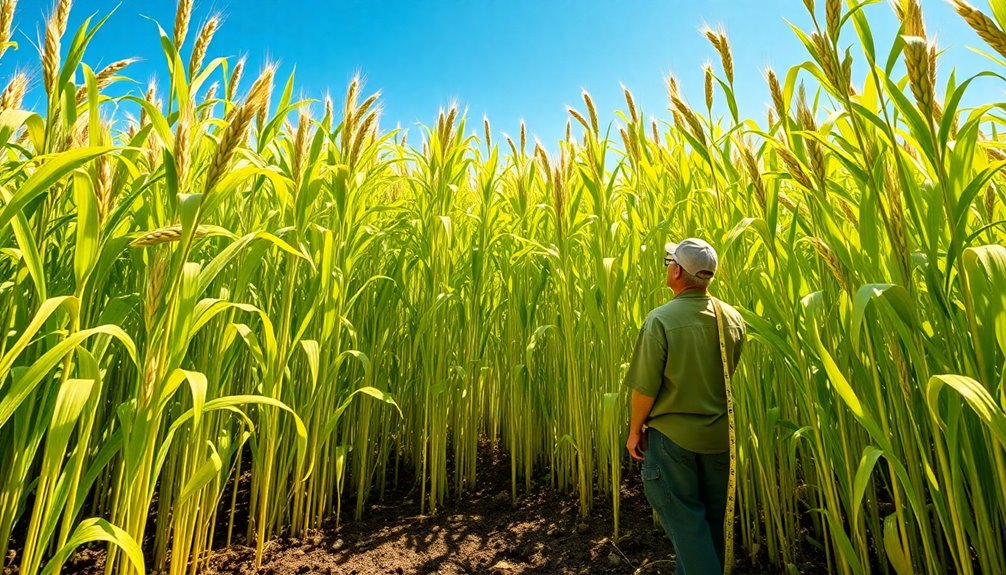
When it comes to effective planting strategies for forage oats, timing and preparation are essential for success. Aim to plant your oats in late August to early September, with the first week of September being the ideal window. This timing allows for better establishment and attracts deer more effectively.
Before you plant your oats, don't forget to apply soil amendments like lime and fertilizer. These enhancements create nutrient-rich soil, improving forage quality and making your plot irresistible to deer.
Consider using a standard 80-pound bag of feed oats, which can cover nearly an acre, making it a cost-effective choice at around $12 per acre.
After planting, keep an eye on deer feeding patterns, especially post-frost. The fresh oat grass becomes markedly more appealing and nutritious after frost exposure, so adjusting future planting strategies based on this observation can lead to even better results.
Managing Height for Optimal Forage

To achieve ideal forage, managing the height of your oats is essential. Forage oats can grow between 2 to 4 feet, but keeping them at an ideal height enhances both palatability and deer attraction.
Here are key strategies to take into account:
- Maintain early growth at 3-4 inches for tender shoots.
- Mow when oats exceed desired heights to promote new growth.
- Monitor soil quality, moisture, and temperature for ideal growth.
- Avoid excessive height to reduce lodging risks. Best outdoor survival bags are designed to help adventurers carry essential gear efficiently.
- Timing your management can maximize nutrient availability. Additionally, consider incorporating essential oils into your farming practices for potential pest control benefits. Moreover, maintaining optimal forage height can ensure efficient heating for livestock by providing them with adequate nutrition and comfort.
Economic Benefits of Forage Oats

When considering forage oats, you'll find they're a cost-effective crop choice that can boost your profitability.
With rising market demand for high-quality forage and its nutritional benefits for livestock, growing forage oats makes more sense than ever.
Cost-Effective Crop Choice
Forage oats present an economically advantageous crop choice for farmers looking to maximize productivity and profitability.
While the initial seed cost may be higher—around $15 more per 48-pound bag compared to traditional oats—the benefits far outweigh this expense. You can expect forage oats to yield 3-5 times more tillers, greatly boosting your overall output.
Here are some compelling reasons to evaluate forage oats:
- Higher yield potential increases productivity.
- Selling prices for oat hay range from $6 to $7 per bale.
- Lower input costs lead to better profit margins.
- Reduced winter feed expenses enhance profitability.
- Access to niche markets for high-quality forage.
Increasing Market Demand
As demand for high-quality forage continues to rise, farmers are finding that forage oats offer not just a viable crop option but also significant economic benefits.
With the average market price for forage oats climbing to between $6 and $7 per bale, the financial incentive is clear. These oats typically yield more than traditional varieties, with reports of 100-120 bales per acre for winter varieties, enhancing your profit margins even further.
The increasing market demand for gluten-free products has also boosted the value of oats, carving out a profitable niche for those focusing on forage oats.
Lower input costs associated with growing forage oats compared to other grains mean you can maximize returns while minimizing expenses. This not only makes forage oats an attractive option for livestock feed but also strengthens their economic appeal.
As the market for high-quality forage continues to grow, forage oats stand out as a smart investment. Diversification strategy in crop selection can further enhance financial stability.
They can effectively reduce your feed costs during the winter months, ensuring that you stay ahead of the competition while reaping the rewards of your hard work.
Nutritional Livestock Benefits
A significant advantage of incorporating forage oats into your livestock feeding strategy is their exceptional nutritional profile.
Forage oats aren't only rich in fiber and protein but also improve the digestibility of feed, which boosts livestock growth rates and overall health. This enhanced digestibility leads to better feed conversion efficiency, making forage oats an invaluable resource. Research indicates improved engagement in STEM subjects can be paralleled in livestock management practices that utilize innovative feeding strategies. Additionally, the use of herbal alternatives has been shown to improve the health of livestock, further enhancing their performance. Furthermore, the incorporation of forage oats can lead to higher yields in livestock production due to their nutrient-rich composition.
Consider these benefits:
- High fiber content supports digestive health.
- Excellent protein source for cattle and sheep.
- Increased energy levels for improved performance.
- Economic savings on winter feed costs.
- High yield potential, reaching 100-120 bales per acre.
Additionally, these oats can serve as a source of nutritional livestock benefits, promoting overall well-being and productivity in the herd.
Frequently Asked Questions
How Tall Do Forage Oats Get?
Forage oats typically grow between 2 to 4 feet tall, depending on the variety and growing conditions.
You'll notice that winter oats often reach greater heights due to their hardiness. In the early stages, they can hit 3-4 inches, which deer find most appealing.
However, factors like soil quality, moisture, and planting density can affect their height. Proper management is key, as excessive growth can lead to reduced palatability and lodging issues.
How Tall Will Oats Get?
When you're growing oats, you might notice they can reach heights of 2 to 4 feet, depending on the variety and conditions.
If you're aiming for deer attraction, keep them around 3-4 inches during the juvenile stage. Taller oats may lose palatability, so it's essential to monitor their growth.
Factors like soil fertility, moisture, and temperature will also influence how tall your oats ultimately get, so stay attentive to those conditions.
What Are the Highest Yielding Forage Oats?
If you're looking for high-yielding forage oats, consider varieties like 'Haybuster' and 'BFO'.
These can produce up to 100-120 bales per acre when you manage them properly.
Depending on your soil quality and weather conditions, you might see average yields ranging from 60 to 140 bushels per acre.
How Tall Should Oats Be Before Grazing?
You know that feeling when you spot a perfect patch of oats? Before you graze, make sure they're about 3 to 4 inches tall.
At this height, they're tender and palatable, attracting more deer and maximizing their nutritional value. If they grow taller than 8 to 10 inches, their taste diminishes, and the animals won't be as interested.
Conclusion
In the world of farming, forage oats can be your secret weapon, towering like giants in a lush green field. By understanding their growth factors and ideal conditions, you'll not only boost your yields but also attract hungry deer, turning your land into a thriving ecosystem. Embrace the potential of forage oats, and watch as your hard work pays off, transforming your farm into a verdant paradise reminiscent of the Garden of Eden. Don't miss out on this opportunity!
Uncategorized
What Are Foraging Societies? Inside the Lifestyle That Defies Modernity!
Uncover the fascinating world of foraging societies, where ancient traditions challenge modern living—what secrets can they reveal about our connection to nature?
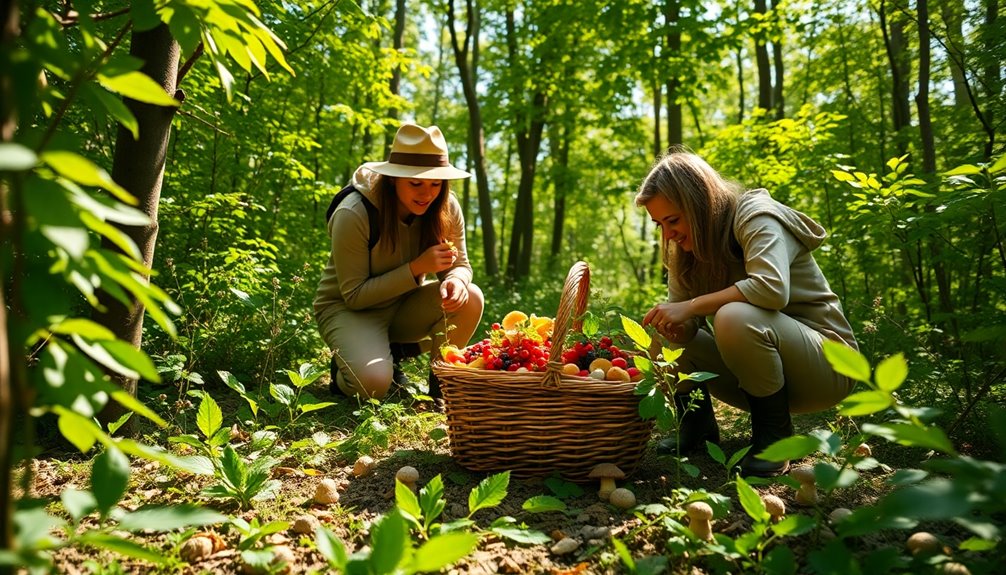
Foraging societies, often called hunter-gatherers, embody a lifestyle that thrives on the natural world. You'll find these groups relying on wild plants and game for sustenance, emphasizing community and cooperation over individual wealth. They typically live in small, egalitarian groups and spend only a few hours each day gathering food, leaving time for social activities. Gender roles play a significant part, with men hunting and women gathering, yet both contribute equally to survival. This ancient way of life offers valuable lessons today, revealing how a connection to nature can enrich your experience. Discover more about this compelling lifestyle!
Key Takeaways
- Foraging societies, or hunter-gatherers, rely on wild plants and animals for sustenance, emphasizing resource sustainability and community cooperation.
- Characterized by egalitarian social structures, they prioritize sharing, respect for elders, and cooperative child-rearing practices among small groups.
- Daily work hours are limited to 4-6, allowing ample leisure time for social activities and cultural exchanges with neighboring groups.
- These societies have existed for over 200,000 years, evolving through climate changes and adapting to their environments while maintaining traditional practices.
- Modern interest in foraging promotes sustainable practices, biodiversity, and connections to nature, encouraging ethical harvesting and appreciation for natural resources.
Definition of Foraging Societies
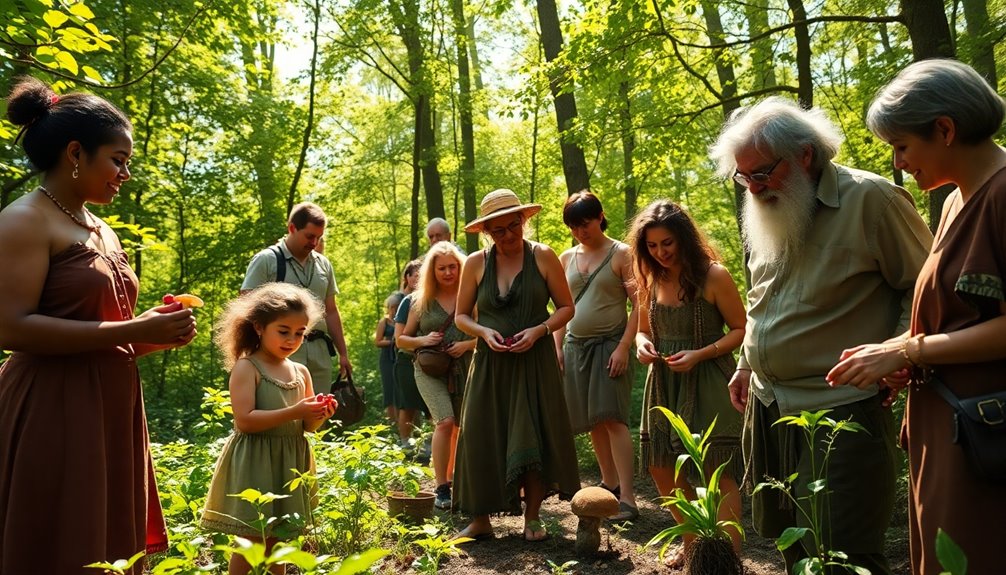
Foraging societies, often called hunter-gatherer societies, depend on wild plants and animals for food instead of farming or raising livestock. You'll find that these societies have a diverse diet, gathering fruits, nuts, roots, tubers, and berries while hunting various animals. This adaptability demonstrates their extensive ecological knowledge, enabling them to exploit multiple food sources effectively.
In foraging societies, food is consumed shortly after it's gathered or hunted, making it the only immediate return subsistence system. This means you won't see much food storage, as the focus is on immediate sustenance.
The community sizes are typically small, often ranging from 20 to 50 individuals. This creates an environment that minimizes pressure on resources and fosters social cohesion through sharing.
The social structures in foraging societies are generally egalitarian. You'll notice a cultural emphasis on sharing and cooperation, which helps to minimize wealth disparities and guarantees a more equal distribution of resources.
This way of life not only sustains individuals but also strengthens community bonds, reinforcing the importance of mutual support in their daily existence.
Historical Context and Evolution
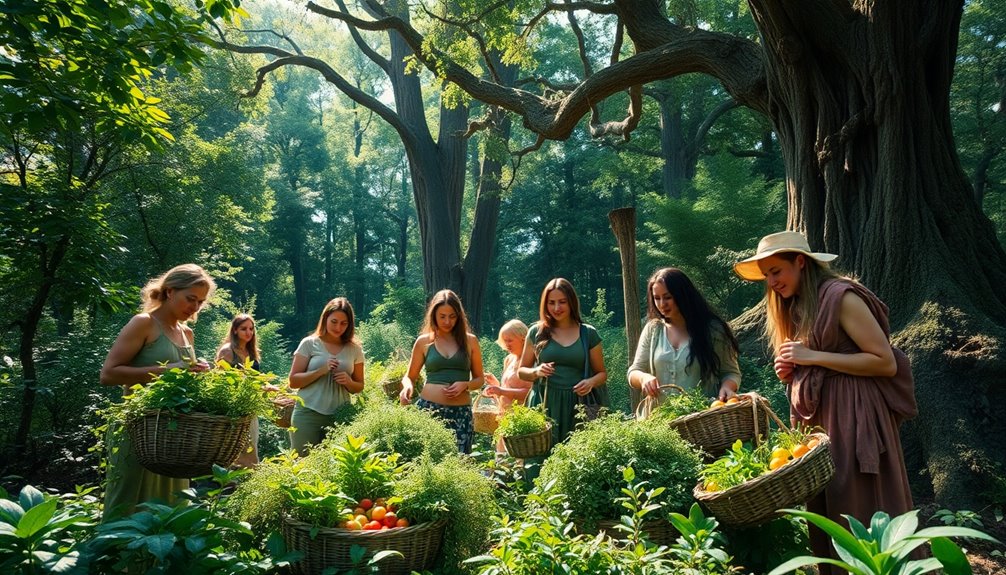
Foraging societies have roots that stretch back over 200,000 years, long before agriculture took hold.
As climate changes shifted landscapes, some groups began experimenting with plant cultivation around 12,000 years ago, marking the shift to agricultural practices.
Understanding these origins and the impact of environmental factors can shed light on how these societies evolved over time.
Origins of Foraging Societies
Long before agriculture shaped human societies, small groups of people thrived by hunting and gathering, adapting to their environments for survival. Foraging societies have existed for around 250,000 years, relying on the natural resources around them.
These foraging groups mastered the art of tracking animals and identifying edible plants, allowing them to sustain their communities without the need for farming.
While agriculture began to emerge around 12,000 years ago, driven by climate changes and resource availability, many foraging groups continued their traditional ways.
Archaeological evidence from sites like Gobekli Tepe and Stonehenge highlights the complexity of these societies, showing that even in pre-agricultural times, they'd organized social structures and engaged in ritual practices.
Additionally, protoagricultural practices suggest that some hunter-gatherers experimented with plant domestication, hinting at an evolutionary path toward agriculture.
However, the decline of these foraging cultures began about 500 years ago, influenced by environmental shifts, colonialism, and the spread of agricultural practices.
Your understanding of these origins sheds light on the resilience and adaptability of human societies throughout history.
Transition to Agriculture
As hunter-gatherer societies flourished for thousands of years, shifts in climate and resource availability began to reshape human lifestyles. About 12,000 years ago, the change from foraging to agriculture emerged, driven by the domestication of plants and animals. This gradual shift marked a significant change in social and economic structures.
In fertile regions, particularly river valleys, early agricultural communities started to thrive. Here are some key elements of this change:
- Resource Abundance: Favorable climates and plentiful wild food sources motivated communities to settle and experiment with cultivation.
- Social Change: As agriculture took root, populations grew, leading to the establishment of permanent settlements and more complex social hierarchies.
- Cultural Diversity: While some groups embraced farming, many foraging communities continued their traditional practices, showcasing the richness of human adaptation.
The decline of hunter-gatherer cultures became pronounced around 500 years ago, as agricultural societies expanded and altered ecosystems.
This change from foraging not only transformed human existence but also laid the foundation for the modern world, illustrating the diverse paths humanity has taken in response to changing environments.
Impact of Climate Change
Climate change has dramatically shaped the trajectory of human societies, particularly in how they adapted their lifestyles over millennia. Foraging communities faced significant challenges as shifting temperatures and changing ecosystems influenced resource availability. During the last Ice Age, these groups had to modify their foraging strategies to survive in varying environments, showcasing their resilience and adaptability.
As the Ice Age came to an end around 10,000 years ago, a warming period emerged, allowing for denser populations and resource exploitation in fertile regions. This change marked the gradual shift from foraging to agricultural practices.
Evidence indicates that climate variability, including droughts and periods of abundance, directly impacted the stability and success of foraging groups, affecting their social structures and mobility.
In some areas, the pressures of climate change ultimately led to the decline of foraging societies, as diminishing resources forced these communities to adopt sedentary agricultural lifestyles.
Understanding the impact of climate change on foraging communities reveals not just their adaptability but also the profound influence environmental factors have had on human development throughout history.
Characteristics of Foraging Life
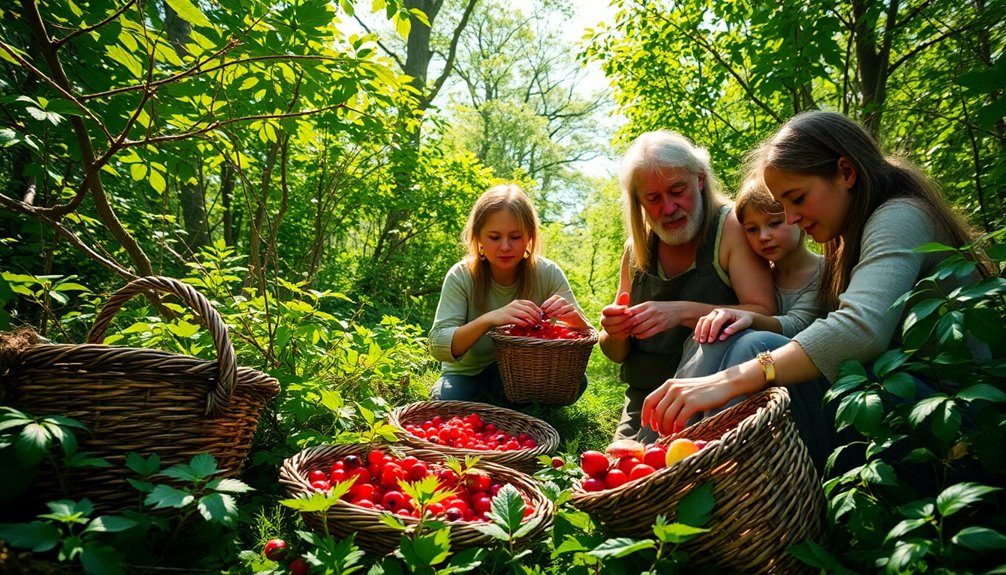
In foraging societies, you'll notice a nomadic lifestyle that drives groups to move regularly in search of food, creating a unique dynamic within their communities.
Social structure plays a significant role, with age often dictating respect and power rather than wealth or gender.
These characteristics shape not only daily life but also interactions with other groups, fostering connections and exchanges that enrich their culture.
Nomadic Lifestyle Dynamics
Foraging societies often thrive in dynamic environments, moving in small groups of 20-50 individuals to tap into seasonal food resources while evading predators. This nomadic lifestyle dynamics allows them to adapt to their surroundings effectively.
You'll find that these groups typically work only 4-6 hours a day, leaving plenty of leisure time for social interaction and physical activities.
Key characteristics of this lifestyle include:
- Childbirth Spacing: Foragers practice spacing between births to maintain manageable group sizes, ensuring sustainability in their nomadic lifestyle.
- Social Interactions: Connections with neighboring communities foster early trade networks and cultural exchanges, enriching their social dynamics.
- Respect for Elders: Age-based social divisions mean that older members are valued for their knowledge and experience, rather than wealth or gender.
Through these dynamics, foraging societies create a balanced way of life, prioritizing resource access while maintaining strong social bonds.
Social Structure and Roles
Social structures in foraging societies are often characterized by their egalitarian nature, where groups of 20-50 individuals work together closely. This small size fosters strong community bonds and resource sharing. Decisions are made collectively, minimizing wealth disparities and promoting social equality.
| Role | Description | Impact on Community |
|---|---|---|
| Men | Generally responsible for hunting | Provides protein, essential for survival |
| Women | Primarily gather plant-based foods | Contributes markedly to the diet |
| Elders | Hold higher social status due to experience | Influence resource distribution and community dynamics |
In these communities, gender roles can vary, but both men and women play vital parts in ensuring the group's survival. Elders often guide decision-making, drawing from their accumulated knowledge. Additionally, cooperative child-rearing practices strengthen social ties, ensuring that children receive care and protection from all members. This social structure allows for resilience against environmental challenges, highlighting the importance of collaboration in foraging societies.
Social Structure and Governance

How do the unique characteristics of foraging societies shape their social structure and governance? In these communities, you'll find an egalitarian social structure that minimizes wealth disparities and promotes sharing. This creates a strong sense of equality among members, which is essential for survival in resource-scarce environments.
Key aspects of their governance include:
- Elder Influence: Elders often hold higher social status, especially if they possess valuable skills in healing or rituals, guiding resource distribution.
- Cooperative Child-Rearing: This practice fosters social cohesion, allowing community members to support one another in raising children.
- Low Population Density: With typically fewer than five people per square mile, foraging societies reduce pressure on food resources, allowing for sustainable living practices.
In this setting, individuals work together to guarantee the well-being of the entire group.
While gender roles do play a part in tasks like hunting and gathering, the overall social structure emphasizes collaboration and shared responsibility.
Gender Roles in Foraging Communities
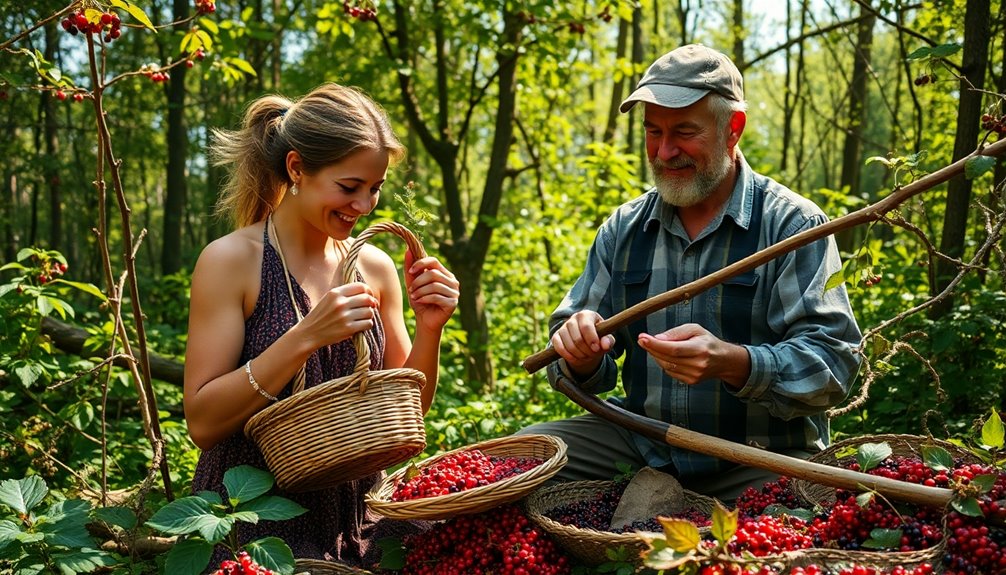
In foraging communities, you'll notice a clear division of labor based on gender, where men typically hunt large game and women gather essential plant-based foods.
This division not only shapes daily life but also influences social status, as hunting often garners more prestige despite the vital role of gathering.
Additionally, the collective effort in child-rearing reflects a shared responsibility that strengthens community ties and challenges traditional notions of hierarchy.
Division of Labor
Foraging societies often rely on a distinct division of labor based on gender, where men typically take on the role of hunting large game while women focus on gathering plant-based foods. This division of labor is essential for community survival and helps maintain a balanced diet. Notably, women can contribute up to 70% of the caloric intake through their gathering efforts.
Here are some key points about this division of labor:
- Egalitarian Social Structure: Foraging communities often minimize wealth disparities, promoting sharing and reinforcing the importance of both genders' contributions.
- Cultural Variability: Roles can vary greatly across different cultures, reflecting the adaptability of these societies to their environments.
- Elder Status: Elders, especially those knowledgeable in healing and rituals, hold higher status and influence resource distribution, further shaping social dynamics.
Understanding the division of labor in foraging societies provides insights into early human behavior and social organization. It highlights how men and women worked together to guarantee the community's survival, a dynamic that continues to inform archaeological interpretations of ancient populations.
Gender-Based Roles
Throughout history, gender roles in foraging communities have shaped the way societies functioned and thrived. In these societies, gender-based roles often dictate the division of labor, with men mainly hunting large game while women gather plant-based foods. This division can vary based on cultural context, but it's essential to recognize that women typically contribute considerably to the community's diet through gathering, often providing the majority of the food. Despite this, their contributions may not receive the same social recognition as those of male hunters.
Interestingly, gender roles in foraging societies tend to be more egalitarian compared to agricultural societies. You'll find less pronounced wealth disparities and a cultural emphasis on sharing resources, fostering a sense of community. Elders, regardless of gender, often hold a higher social status due to their knowledge and experience, influencing resource distribution.
Additionally, cooperative child-rearing practices in these communities showcase shared responsibilities across genders, enhancing social cohesion and supporting child development.
Social Status Influence
Gender roles in foraging communities greatly shape social status and influence how resources are distributed. In these societies, men often take on hunting roles, while women focus on gathering plant-based foods. However, this division can vary by culture, and the contributions of women are sometimes undervalued compared to the visible status associated with hunting.
Here are some key points about social status in foraging societies:
- Elders hold high status: Regardless of gender, elders command respect due to their accumulated knowledge and skills.
- Egalitarian principles: Foraging societies emphasize sharing and cooperation, minimizing wealth disparities and fostering community ties.
- Impact on archaeology: Understanding gender roles can help you interpret early human behavior and the importance of social structures.
These dynamics show that while gender roles influence social status, the overall structure of foraging communities promotes cooperation and resource sharing. By recognizing the value of both hunting and gathering, you can appreciate the complex interplay between gender roles and social status in these societies.
Dietary Practices and Resource Use
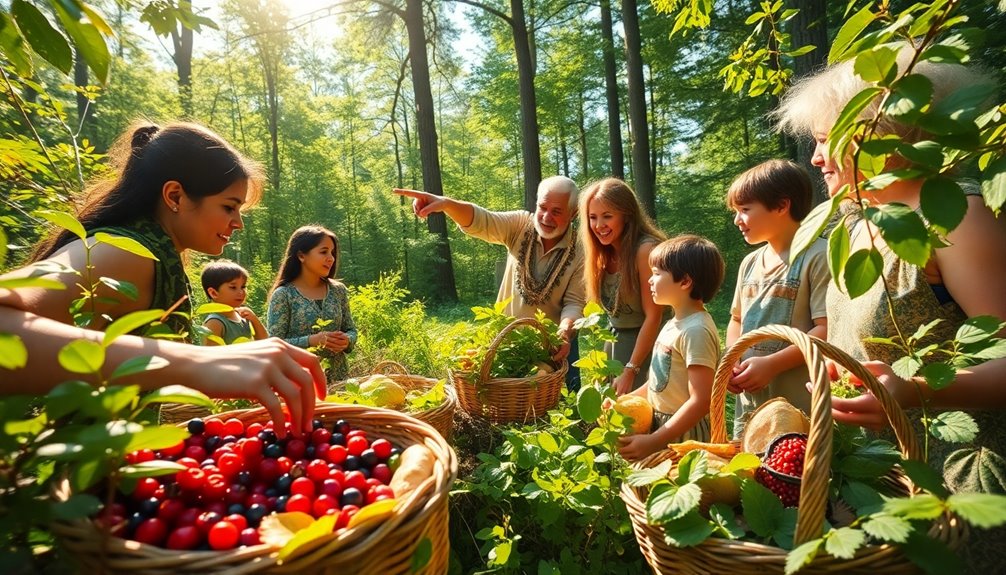
Diverse diets are a hallmark of foraging societies, where people gather a wide array of foods from their natural environment. Your dietary practices will typically include fruits, nuts, roots, tubers, and berries, supplying essential calories and nutrition.
You might also engage in hunting, which varies from targeting small game to large mammals, and fishing, where you could harvest everything from coastal shellfish to deep-sea fish.
Insects and worms, often overlooked, are significant in your diet and add to your overall caloric intake. For instance, Ach foragers are known to consume over 33 mammal species and 40 different plant species, demonstrating impressive ecological knowledge and resource utilization skills.
Resource scarcity in foraging societies shapes your social dynamics, fostering cooperation and sharing among group members. This cooperation is vital for maintaining social cohesion and ensuring the survival of the group.
Health and Life Expectancy
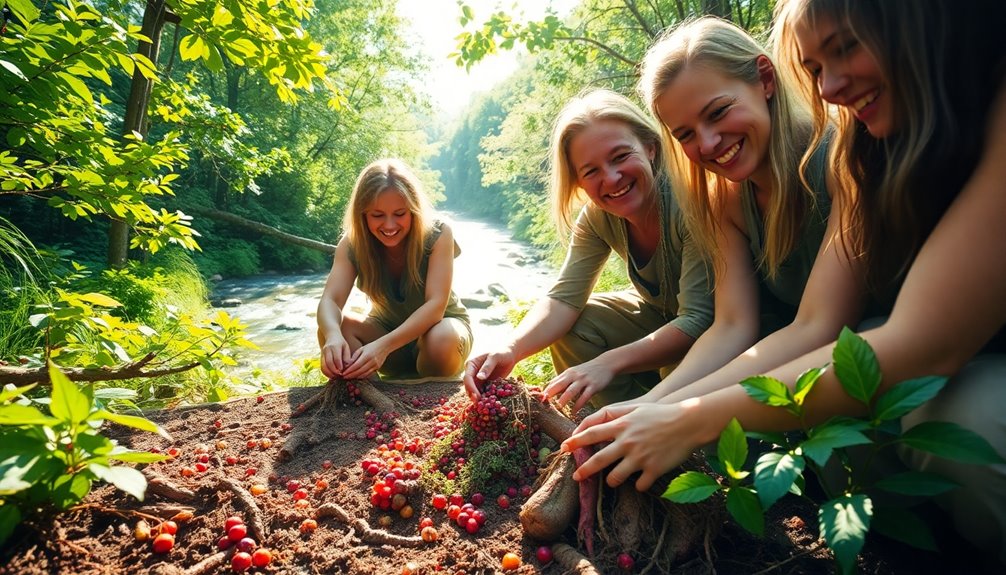
The health and life expectancy of foragers contrast sharply with those in modern societies, despite their varied diets and active lifestyles. While foragers typically had shorter life expectancies, averaging between 21 and 37 years, modern averages hover around 66 years.
However, the health benefits of their lifestyle shouldn't be overlooked. Foragers often enjoyed:
- Healthier diets rich in diverse foods, leading to better overall nutrition.
- Increased physical activity due to their nomadic way of life, which promoted fitness.
- Strong social interactions that fostered community bonds and emotional well-being.
Interestingly, some longevity studies suggest that certain hunter-gatherer populations might've had higher life expectancies than previously thought.
Though they faced challenges like violence and social complexities, their active lifestyle and nutritious diets contributed positively to their health.
Ultimately, while their life expectancy may seem low by modern standards, the foraging lifestyle offers valuable insights into the relationship between health, diet, and longevity.
You might find that embracing aspects of their way of life could enhance your own health and well-being.
Modern Resurgence of Foraging
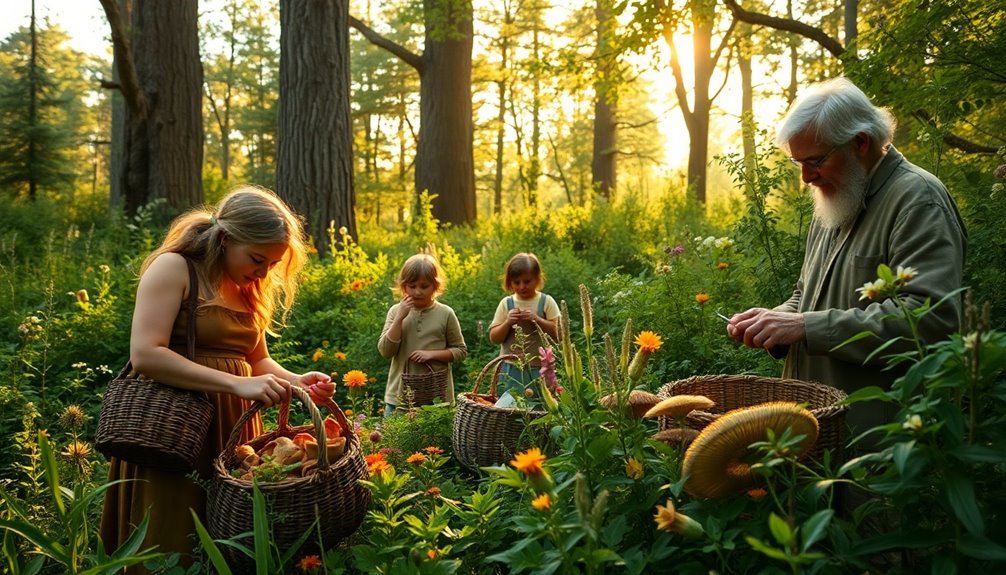
Revitalizing an ancient practice, foraging has seen a modern resurgence as people in urban areas seek to reconnect with nature and enhance self-sufficiency. You might find that engaging in foraging not only provides fresh, free food sources but also allows you to supplement your diet with seasonal and wild edibles.
As you explore local parks or even your backyard, you can discover a variety of plants and mushrooms that enrich your meals. Social media influencers have greatly contributed to this trend, sharing foraging techniques, recipes, and the many benefits of sourcing food from the wild.
This newfound interest encourages a deeper appreciation for natural resources and sustainable food practices. By embracing the modern resurgence of foraging, you're also participating in efforts to control invasive species and promote biodiversity, utilizing local ecosystems sustainably. Many foragers also benefit from understanding mushroom foraging techniques, which enhances their ability to safely identify and harvest edible varieties.
As you immerse yourself in this lifestyle, you'll likely develop a stronger connection to the environment and foster a more environmentally conscious approach to living. The modern resurgence of foraging isn't just about food; it's a movement toward a healthier, more self-reliant way of life, deeply rooted in nature.
Safety and Ethical Considerations
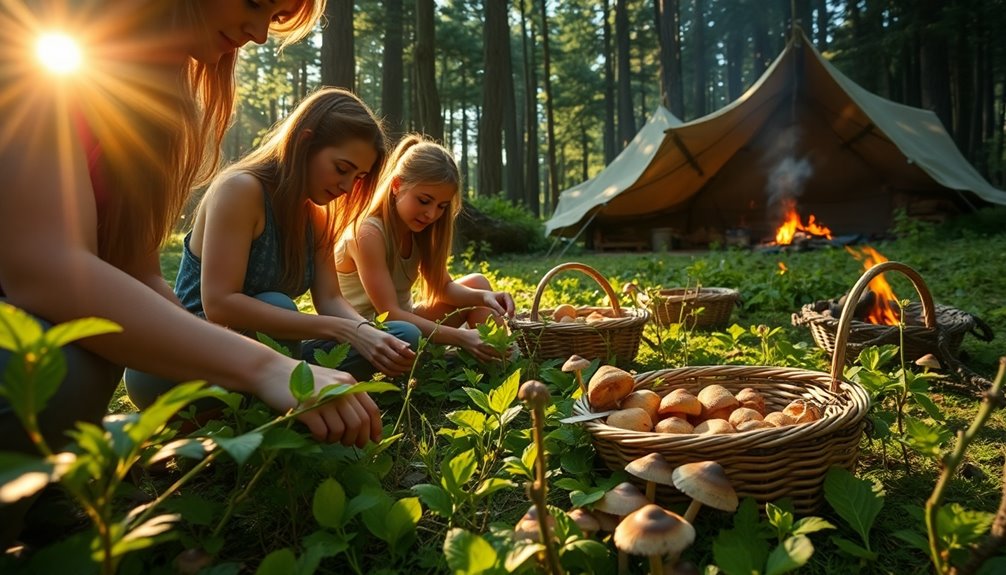
Foraging can be an exciting adventure, but it's crucial to prioritize safety and ethics while you explore. You need to be aware of the potential risks, especially when it comes to plant identification. Consuming the wrong plant can lead to serious health issues, so always confirm what you're foraging.
Here are some tips to keep you safe and ethical:
- Start with small portions of foraged foods to test for allergies and adverse reactions.
- Consult local guides or experts who can teach you about edible species and safe foraging techniques.
- Practice sustainable foraging by leaving some plants behind to encourage growth and maintain biodiversity. Additionally, consider using multi-functional gear to enhance your foraging experience and ensure you have the right tools on hand.
Archaeological Insights and Discoveries
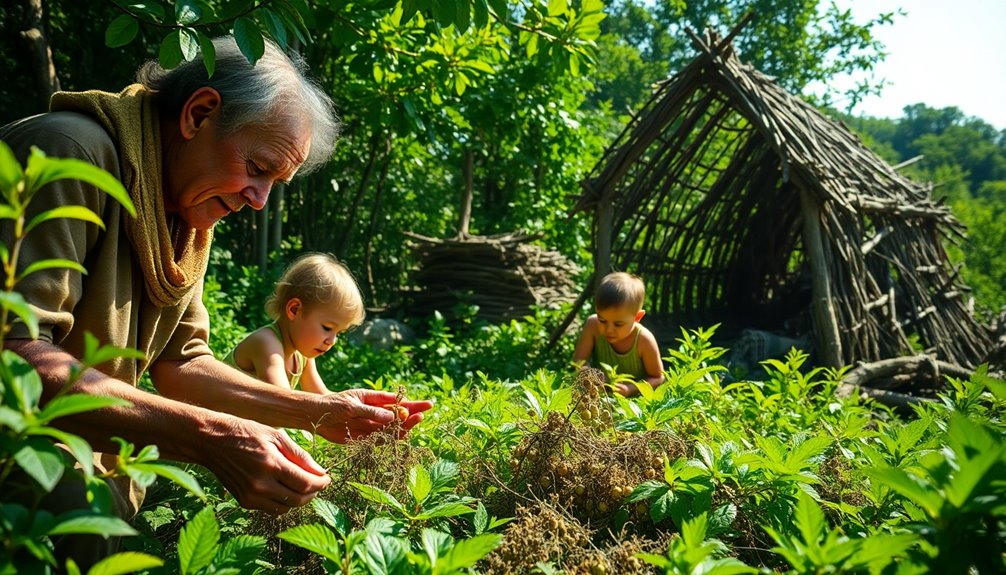
Archaeological discoveries offer fascinating insights into the lives of foraging societies, revealing their intricate social structures and rich cultural practices. Key sites like Gobekli Tepe and the Altamira cave paintings showcase the complex societal organization and artistic expression of these groups.
You'll find that excavations have uncovered evidence of foragers utilizing a diverse range of resources, with over 33 mammal species and 40 plant species consumed by groups like the Ach foragers.
Additionally, studies of sites like Stonehenge highlight the ritualistic and communal aspects of foraging communities, illustrating their social interactions and cultural practices. These archaeological insights indicate that foraging societies maintained trade networks and cultural exchanges with neighboring groups, greatly contributing to early social structures.
Moreover, the analysis of ancient tools and artifacts from these sites enhances our understanding of technological advancements and resource utilization in prehistoric human societies.
Frequently Asked Questions
What Are Foraging Societies?
Foraging societies are groups that rely on hunting and gathering for survival.
You'll notice they typically consist of small, mobile communities, often moving seasonally to find food. Their diets can be quite diverse, including fruits, nuts, and various animal species.
In these societies, social structures tend to be egalitarian, with men hunting and women gathering.
Despite the modern world, these groups showcase resilience and adaptability in utilizing natural resources for sustenance.
Do Foraging Societies Exist Today?
Yes, foraging societies do exist today.
You'll find groups like the San people and the Inuit still practicing traditional hunting and gathering. Even in urban areas, many individuals embrace modern foraging, seeking wild foods and natural ingredients.
This lifestyle emphasizes sustainability and environmental stewardship, showcasing a deep connection to nature.
However, these communities face challenges from land rights issues and industrial encroachment, threatening their traditional ways of life.
What Is Forage in Sociology?
In sociology, foraging refers to the practice of obtaining food by hunting, gathering, and fishing rather than through agriculture or livestock.
You rely on wild resources, utilizing your knowledge of the environment to find edible plants and animals. Foragers often work in groups, sharing their finds to promote cooperation and social bonds.
This lifestyle emphasizes sustainability and adaptation, allowing you to thrive within your ecosystem while maintaining a deep connection to nature.
What Is the Foraging Way of Life?
The foraging way of life involves hunting and gathering food directly from nature. You rely on your knowledge of local plants and animal behavior to find diverse resources like fruits, nuts, and game.
This lifestyle requires mobility, as you move to follow seasonal food availability. You'll often work collaboratively within small groups, sharing resources and responsibilities.
Gender roles might divide tasks, but both men and women play essential roles in ensuring the group's survival.
Conclusion
In exploring foraging societies, you glimpse a world where harmony with nature reigns, a melody of survival that dances through the ages. These communities, rooted in simplicity, teach us the art of living with purpose and connection. As modernity rushes by like a fleeting breeze, you can find inspiration in their wisdom, reminding you that beneath the chaos, there's beauty in the basics—a call to rediscover the rhythms of life and nurture the earth that sustains us.
Uncategorized
Is Forage Good for Internship? The Shocking Truth About This Opportunity!
Get ready to discover whether Forage can truly transform your internship experience in ways you never expected! What secrets lie ahead?
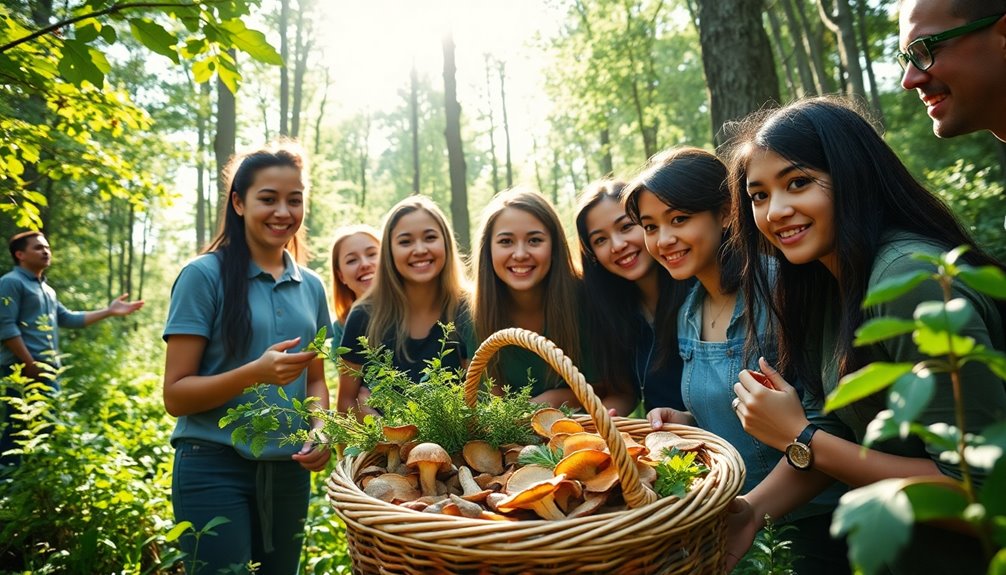
Forage is a fantastic opportunity for internships, especially if you're looking to build skills without the usual pressures. These virtual internships are structured by top companies and allow you to learn at your own pace. You won't face competitive applications, and they're free, making them accessible to everyone. You'll gain practical experience with tools and concepts relevant to your field. Plus, completing these programs gives you a recognized digital certificate to enhance your resume. If you're curious about how to make the most of this unique chance, you'll uncover essential tips just around the corner.
Key Takeaways
- Forage offers free virtual internships that enhance resumes with recognized digital certificates, making them a valuable addition for job applications.
- The self-paced format of Forage programs allows flexibility, enabling participants to learn without the pressure of strict schedules or assessments.
- Designed by leading companies, Forage internships build practical skills through real-world simulations, preparing participants for industry challenges.
- The programs are accessible to a diverse audience, including international students and those without prior work experience, promoting inclusivity in career exploration.
- Engaging in multiple Forage programs creates a well-rounded skill set, boosting confidence and employability for aspiring professionals.
Understanding Forage Programs

For those looking to gain real-world experience, Forage programs offer an excellent way to immerse yourself in virtual internships created by top companies in various fields. These programs span disciplines like marketing, engineering, banking, and law, providing you with valuable insights and skills directly relevant to your career aspirations.
Each Forage program typically takes about 4–5 hours to complete and includes self-paced modules filled with introductory videos, engaging assignments, and personalized feedback from industry professionals. This structure allows you to tackle real work scenarios, honing your practical skills while learning how to navigate tasks similar to those you'd encounter in a traditional internship.
When you finish a program, you receive a digital certificate that enhances your LinkedIn profile and resume, showcasing your practical experience to potential employers. This accessibility makes Forage an inclusive opportunity for everyone, including international students and those with no prior work experience.
Benefits of Virtual Internships

Virtual internships offer you the flexibility to learn on your own schedule, making them accessible no matter where you are.
You'll have the chance to develop valuable skills through real-world tasks, which prepares you for the job market. Additionally, hydration is crucial for maintaining optimal brain function during your learning process.
Plus, with no grades or assessments, you can focus on genuinely engaging with the content to enhance your personal growth. Additionally, they often encourage self-care practices that contribute to your overall well-being during the learning process.
Flexibility and Accessibility
While many internships come with rigid schedules and extensive application processes, the flexibility and accessibility of virtual internships, like those offered by Forage, make them an appealing option for students everywhere.
You can immerse yourself in these self-paced experiences without the hassle of applications or fees. This means you can explore your interests while managing your other commitments.
Here are three key benefits of virtual internships:
- Self-Paced Learning: Complete simulations in just 4–5 hours, allowing you to fit the work around your class schedule or job.
- Wide Range of Opportunities: Explore various career pathways, from marketing to engineering, giving you a taste of multiple fields before you commit.
- No Pressure: With no grading or assessments, you can focus on developing genuine skills instead of stressing over performance metrics.
These features not only offer you the flexibility to learn on your terms but also enhance your resume with valuable certificates, positioning you favorably for entry-level positions. Additionally, you can benefit from the optimal tanning frequency recommended in skin health guidelines to maintain your well-being while pursuing your internship.
Virtual work through Forage truly opens doors for every student, making internships more accessible than ever.
#
Skill Development Opportunities
Often, students discover that virtual internships offer invaluable skill development opportunities that prepare them for the workforce. Forage provides virtual Experience Programs that focus on building practical skills essential for entry-level positions, with programs designed by leading companies across various disciplines, including marketing and engineering. These programs not only enhance industry-specific skills but also promote teamwork skills crucial in collaborative work environments. Additionally, developing a strong brand identity through these experiences can significantly enhance your employability. Moreover, engaging in these simulations can also help you learn about the importance of risk management strategies in navigating professional challenges. The use of AI-powered technologies in these programs can also enhance the learning experience, making it more engaging and tailored to individual needs AI technologies.
You can complete self-paced simulations in about 4–5 hours, allowing you to efficiently develop skills without the pressure of grading or assessments. The platform emphasizes hands-on experience, enabling you to enhance your design, prototyping, and strategic thinking abilities through real-world tasks faced in the industry.
As you engage with Forage's simulations, you'll not only boost your confidence during job searches but also learn to manage feelings of rejection by recognizing the importance of practical experience in your career development. Additionally, immersing yourself in these simulations can help you understand the significance of collaboration across teams in achieving project success.
Plus, the certificates awarded upon completion of these simulations add significant value to your resume. They complement your online courses and certifications, making you a more appealing candidate to potential employers.
## Skill Development Opportunities

Skill development opportunities through Forage provide a unique way to enhance your resume while gaining practical experience.
As you engage with self-paced virtual internships, you'll find that these programs allow you to manage your time effectively while building essential skills.
I've gotten valuable insights from working with industry leaders like Accenture and Electronic Arts.
Here's what you can expect to develop:
- Competencies in Design: You'll learn how to create impactful designs that resonate with your target audience.
- User Research Methodologies: Understanding how to gather and analyze user feedback is vital in today's market.
- Understanding KPIs: You'll grasp key performance indicators relevant to your field, enabling you to measure success accurately.
Real-World Application of Skills

Forage internships provide a practical setting where you can apply the skills you've developed in real-world scenarios. These simulations mimic industry tasks like designing a feature for a music app or strategizing a research plan for product design, giving you hands-on experience relevant to your future career.
You'll engage with industry concepts such as KPIs and user segmentation, which are essential for decision-making in fields like game design. The assignments encourage you to hone your iterative design and prototyping skills, closely reflecting the challenges professionals face daily.
By working with datasets and tools like Microsoft Excel and Tableau, you gain firsthand experience with software commonly used in the workplace. Completing these simulations not only boosts your confidence in applying what you've learned but also enhances your resume with certificates from leading companies.
| Task Type | Tools Used | Skills Developed |
|---|---|---|
| Designing App Features | Microsoft Excel | Prototyping, Design |
| Creating Research Plans | Tableau | Data Visualization |
| Analyzing Game Metrics | Industry KPIs | Decision-Making |
| Working with Datasets | Excel | Data Cleaning |
| Simulating Real-World Tasks | Various Software | Practical Application |
Comparing Forage to Traditional Internships

While traditional internships typically demand a significant time commitment and structured schedules, Forage offers a flexible alternative that can be completed in just 4–5 hours. This allows you to fit skill development into your busy life without sacrificing other commitments.
Here are three key differences between Forage and traditional internships:
- Accessibility: Forage programs are free and don't require an application process, making them open to everyone, including those without prior experience. Traditional internships often have competitive application processes that can be intimidating.
- Learning Style: With Forage, you engage in self-paced learning, promoting independence and personal initiative. Traditional internships usually involve hands-on experience with direct supervision, which can limit your creative freedom.
- Recognition: Upon completing a Forage program, you receive a certificate that can enhance your resume. In contrast, traditional internships often focus more on networking and mentorship, without formal recognition of your accomplishments. Engaging in self-paced learning can also help in developing organizational skills, which are essential for effective time management.
Choosing between these two options ultimately depends on your goals and circumstances, but Forage provides a unique opportunity to gain practical skills without the constraints of traditional internships.
Building Your Resume Effectively

How can you make your resume stand out in a competitive job market? Completing Forage's virtual internships is a powerful way to enhance your resume. Each program you finish earns you a digital certificate that you can proudly display on your LinkedIn profile and resume, showcasing the practical skills you've gained from real-world tasks.
When you list experiences from notable companies like Accenture or Electronic Arts, make sure you go beyond just naming these brands. Focus on detailing your specific contributions and skills, demonstrating how you've engaged with recognized industry practices. This adds credibility and depth to your candidacy.
Since Forage programs are self-paced, you can tailor your learning experiences to fit your personal projects, further integrating these skills into your resume.
Consider participating in multiple programs across various disciplines. This approach creates a well-rounded portfolio that highlights a broad skill set, making you more appealing to potential employers in diverse fields. Additionally, many employers conduct background checks to verify candidate information, so showcasing your skills and experiences can significantly impact your chances of securing an internship.
Insights From Personal Experiences

Engaging in virtual internships can transform your understanding of the job market and your personal capabilities. With Forage, you can complete programs in just 4–5 hours, giving you the chance to acquire practical skills without the stress of grading. Additionally, these experiences can help you develop key skills such as risk assessment, which are highly valued in various industries. Trust creation can be a vital skill in networking and building professional relationships, enhancing your workplace dynamics. Reading about best parenting books for discipline can also enhance your understanding of how to handle various workplace dynamics.
You'll find diverse opportunities from reputable companies like Lululemon and Accenture, which can greatly enhance your resume's credibility.
Here are three key insights from participants like you:
- Self-Reflection: You'll compare your work against industry standards, encouraging you to identify strengths and areas for improvement.
- Portfolio Boost: Many users report that these experiences complement traditional education, adding real-world examples to their job applications.
- Confidence Building: Completing these programs helps you manage rejection in your job search, allowing you to focus on practical experiences rather than just credentials. Additionally, engaging in these programs can foster a support network that enhances your learning journey and connects you with peers.
Target Audience for Forage

Forage caters to a diverse audience enthusiastic to kickstart their careers and gain practical experience. It's particularly suitable for individuals with entry-level curiosity and limited experience, making it an excellent option for students looking to enhance their resumes without prior work experience.
Whether you're a high school student or even a middle school student, Forage opens doors for younger audiences interested in exploring various career pathways.
The platform encourages you to pursue personal projects alongside program participation, allowing you to apply what you've learned in real-world contexts for added credibility. This hands-on approach not only helps you build skills but also makes your resume stand out.
Forage experiences are designed to complement your academic knowledge, providing structured opportunities for practical skill development relevant to various disciplines.
You'll find that the focus on personal initiative is key. By actively engaging with the material and tailoring it to your career interests, you can truly maximize your Forage experience.
This way, you're not just learning; you're also building a foundation for a successful career.
Maximizing Your Forage Experience

To maximize your Forage experience, set clear goals for what you want to achieve.
Set Clear Goals
Setting clear goals is essential for maximizing your Forage experience. By establishing specific learning objectives before diving in, you'll stay focused on developing skills that align with your career interests.
Here are three key steps to help you set effective goals:
- Identify Skills: Pinpoint the exact skills you want to enhance. Whether it's project management or data analysis, knowing your targets will guide your learning. Additionally, understanding the importance of energy consumption in various industries can provide a broader context for your skills. Consider how diversifying investments in different areas can improve your overall career trajectory. Engaging in puppy training classes can also help you develop patience and communication skills.
- Allocate Time: Dedicate specific time blocks to complete each simulation. The estimated completion time often underestimates the depth of research and effort required, so plan accordingly to avoid rushing through the material.
- Assess Progress: Regularly check your progress against your goals. This ongoing assessment will help you identify areas for improvement and guarantee you're gaining the intended knowledge.
Additionally, document your achievements and insights, as these will enrich your resume and provide valuable experiences beyond just recognizable company names. Implementing data-driven decision-making can further enhance your learning and application of skills gained during the internship.
Engaging actively with assignments and comparing your work to example models will refine your skills and deepen your understanding of real-world applications.
Engage With Content
Once you've established your goals, the next step is to actively engage with the content offered in the simulations. Approach assignments with a mindset of learning; complete them quickly and view your initial submissions as drafts. This way, you can focus on growth rather than perfection. It's also important to be aware of how user consent management can impact your data privacy while engaging with online platforms. Educational toys, such as STEM toys, can also encourage curiosity and exploration which is a crucial mindset for effective learning. Engaging with high-quality materials can also enhance your understanding and retention of the concepts presented. Furthermore, applying a patch test approach when experimenting with new learning methods can help you identify what works best for you.
Take full advantage of the structured format, which includes introductory videos and feedback. These resources can deepen your understanding of real-world tasks in your chosen field. As you work through the simulations, compare your output to the provided example models. This practice helps you identify areas for improvement and enhances your skill development.
Don't forget to engage in self-reflection after completing each simulation. This will allow you to grasp the dynamics of industry practices and apply them to your personal projects. Concentrate on your own learning and how to apply your new skills in real-world contexts. Additionally, remember that developing a structured routine can significantly enhance your ability to absorb and apply new knowledge effectively.
Key Takeaways for Interns

Interns can considerably boost their career prospects by engaging with Forage's free virtual internships. These programs allow you to gain practical experience without the stress of traditional internship applications.
Here are three key takeaways to maximize your experience:
- Flexible Learning: You can complete these internships at your own pace, typically in just 4-5 hours. This flexibility lets you fit learning into your schedule, making it easier to explore different career paths.
- Resume Enhancement: Upon finishing the simulations, you'll receive certificates that showcase the skills you've developed through real-world tasks. This tangible proof of your abilities can set you apart in competitive job markets.
- Skill Development: Forage emphasizes essential skills like design, user research methodologies, and strategic thinking. Engaging with these programs encourages you to apply what you learn in personal projects, ultimately providing richer experience than simply collecting credentials.
Frequently Asked Questions
Is Forage Good for Internships?
Forage can be a great option for internships. You get the chance to engage in real-world tasks, helping you build practical skills without needing prior experience.
With flexible completion times, you can fit it into your schedule easily. Plus, the certificates you earn can enhance your resume, showcasing relevant abilities to potential employers.
Should You Put Forage on Your Resume?
You might think adding Forage to your resume is like throwing a glitter bomb at a black-and-white movie; it instantly brightens things up!
Absolutely, you should include Forage on your resume. It showcases your initiative, practical skills, and commitment to professional growth.
Plus, that digital certificate? It's like a shiny badge of honor for your LinkedIn profile.
Employers love candidates who take charge of their learning, so don't miss this golden opportunity!
Is Forage Good for College Applications?
Forage can definitely enhance your college applications. By completing their virtual internships, you showcase practical experience and industry-relevant skills, making your application stand out.
You'll earn digital certificates to add to your resume and LinkedIn profile, highlighting your initiative and commitment to career development.
Plus, the hands-on simulations help you build confidence and understanding of various career paths, which colleges appreciate in proactive applicants like you.
How Does Forage Earn Money?
Did you know that 70% of companies now prefer virtual internships?
Forage earns money by partnering with these companies to create and host virtual internship programs. They charge businesses for access to the platform, which enhances employer branding and talent acquisition.
This model not only provides companies with valuable analytics on participant engagement but also connects them to a broader talent pool, all while offering free access to students.
It's a win-win!
Conclusion
In the end, think of a Forage program like a training ground for a marathon. Just as runners build stamina through practice, you're honing your skills and gaining valuable experience. The flexibility of virtual internships allows you to explore various fields, much like trying different running routes. Don't underestimate this unique opportunity; it could be the stepping stone that propels you toward your dream job. Embrace the journey, and watch your career take off!
-

 Foraging Basics2 months ago
Foraging Basics2 months agoAdd a Forage Certificate to Your LinkedIn Profile and Level Up Your Career
-

 Edible Wild Plants2 months ago
Edible Wild Plants2 months agoUnbelievable Power: The World's Most Formidable Forage Harvester
-

 Foraging Basics1 month ago
Foraging Basics1 month agoForage the City: Your Guide to Successful Urban Foraging
-

 Foraging Basics2 months ago
Foraging Basics2 months agoThe Shocking Truth About Foraging (That Experts Don’t Want You to Find Out)
-

 Foraging Basics1 month ago
Foraging Basics1 month agoThe Resume Hack That Will Make Your Foraging Experience Stand Out
-

 Recipes and Preparation2 months ago
Recipes and Preparation2 months agoThe #1 Sought-After Forage That's Transforming Livestock Nutrition
-

 Recipes and Preparation2 months ago
Recipes and Preparation2 months agoThe One Wild Edible That Will Transform Your Cooking (And It’s Free!)
-

 Foraging Basics2 months ago
Foraging Basics2 months agoDiscover the Largest Forage Wagon in the World!














